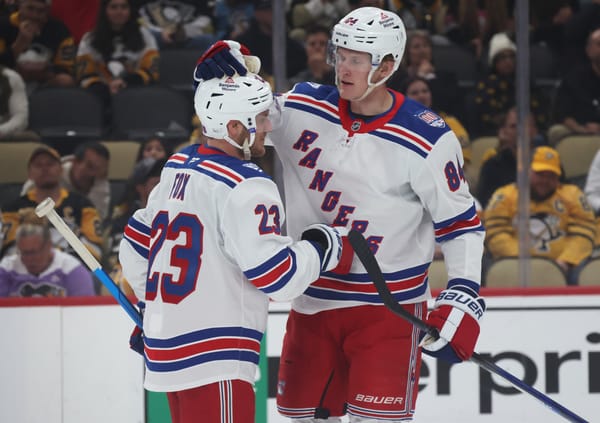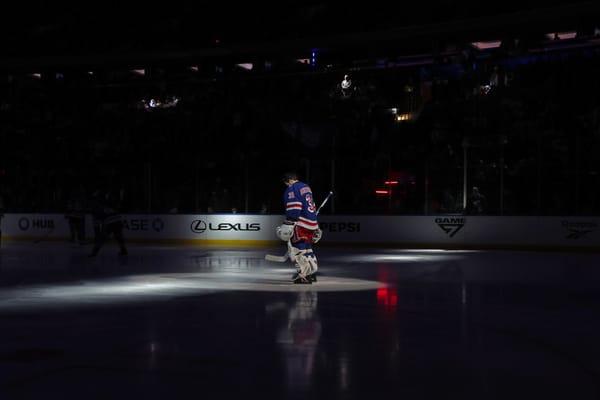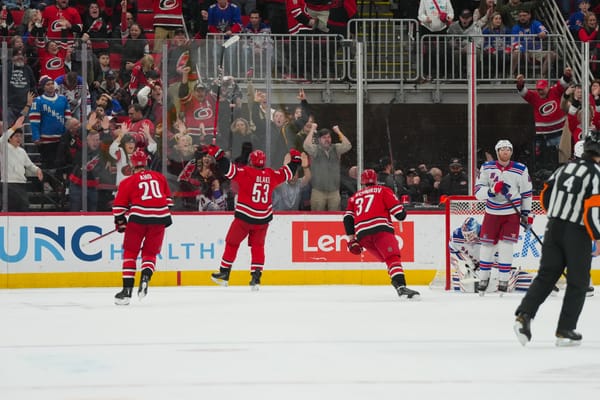Get ready for a big year from Mika Zibanejad
The Rangers top center should flourish playing with Artemi Panarin
The day after the New York Rangers signed big ticket free agent Artemi Panarin, head coach David Quinn made it abundantly clear who he wanted the superstar winger to play with. To no one’s surprise, he wants the $14 million winger lining up next to 26-year-old Mika Zibanejad.
“Obviously we have a plan of playing [Panarin and Mika Zibanejad] together and whether you’re 27 or 35 or 37, you want to continue to get better,” Quinn told NHL.com last month. “Both these guys will continue to improve, want to improve and want to be the best player they can possibly be. I get the sense that [Panarin] certainly isn’t satisfied with where he is in his career. He wants to get to the next level, as does Mika.”
In that interview, Quinn described Panarin as the kind of winger who plays like a center because of the way he can influence the players he’s playing with. Panarin’s playmaking ability has been well-documented since he broke into the league with the Chicago Blackhawks. He managed to set a new personal best in 5-on-5 primary assists last season (29) due in large part to his ability to create chances and make plays.
His production on the power play last season was also noteworthy. The Russian winger had more primary assists on the power play last season (9) than he did in the previous two seasons combined (5;3). Panarin achieved all of this despite playing for a team that had a brutal 15.4 percent success rate on the man advantage.
Of course, it’s no secret that Mika Zibanejad has been a beast for the Rangers when they are on the advantage. Over the last two seasons only six players have scored more goals while the opposition has had at least one man serving a penalty. The only center who has lit the lamp more than Zibanejad (25) on the power play in that span is Steven Stamkos (34). That means that Zibanejad has scored more power play goals than John Tavares, Tyler Seguin, and Sidney Crosby over the last two years.
Starting to get the picture?
In addition to being relevant to your fantasy draft, the combination of Panarin and Zibanejad will almost certainly be the new spearhead of the Rangers’ offense — both on the power play and at evens.
Zibanejad’s most frequent linemate at 5-on-5 last season was Chris Kreider, and it wasn’t close. The center shared 667:55 of ice time with the power forward; Mats Zuccarello was the closest competition among the rest of the team’s forwards with 405:54 shared ice time at 5-on-5. The numbers show that Zibanejad definitely fared better when he played with Kreider, which leads us to wonder how playing with a left winger with a very different skill set and style of play will impact his production.
As an aside, if you’re curious about how Panarin and Kreider differ, Shayna Goldman of Blueshirt Banter and The Athletic examined that and much more in piece she wrote last month. It’s definitely worth a read.
So, how do we set a realistic expectation for Zibanejad’s boxcar stats in 2019-20? Clearly, there’s more nuance to Panarin’s influence than Cam Atkinson going from a player who scored at a rate of 0.95 G/60 at 5-on-5 in the two years he played before Panarin to a player who scored at a rate of 1.22 G/60 with him. Because we’re talking centers, let’s look at Pierre-Luc Dubois.
At 5-on-5, Dubois had a 57.06 xGF% in the 900+ minutes he was on the ice with Panarin and a 42.54 xGF% in about 240 minutes without him. Dubois scored 46 of his 61 points while Panarin was on the ice. The young center comes from a different mold than Zibanejad. The big-bodied pivot generates much of his offense in front of the net — whether he’s taking the shot, tipping it into the net, or jumping on rebounds. He also shoots less than the Rangers’ top center; he put 64 fewer shots on net than Zibanejad last year. Dubois is a left-handed shot, which is why the Russian winger sent most of his passes to Atkinson.
If Zibanejad clicks with his new left winger, there’s reason to believe that he could crack 40 goals in 2019-20. On paper, it looks like a match made in hockey heaven: a play-driving, highly skilled winger who loves to carry the puck playing with a center who is entering his prime and is gifted with an excellent shot. Of course, there’s also the small matter of who the third forward on that top line will be and how that player will contribute to that chemistry.
At the moment, the leading candidates for that role are rookie Kaapo Kakko and the recently extended Pavel Buchnevich. As it turns out, Zibanejad spent more time playing 5-on-5 hockey with Jesper Fast than he did with Buchnevich last season. However, he did have the primary assist on three of the winger’s seven power play goals last year. So, there might be something there.
The bottom line is that Zibanejad should have a big year whether it’s Kakko, Buchnevich, or a rotating cast on his right wing because of the player that is expected to be on his left wing. Over the past three seasons, no winger had a higher rate of earning primary assists at 5-on-5 than Panarin’s 1.13 A1/60. The only players above him in that category were Steven Stamkos, Connor McDavid, and Evgeni Malkin.
That’s the caliber of player that the Rangers added this offseason. And that’s why Zibanejad is primed to set a new career-best in goals for the second consecutive year.
Data courtesy of naturalstattrick.com and corsica.hockey. All salary information courtesy of CapFriendly.com.
Related
How the Offseason Changes the Power Play




